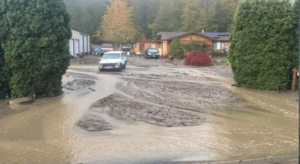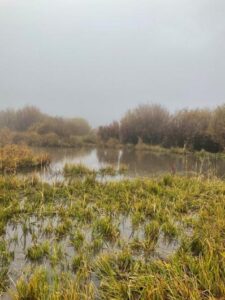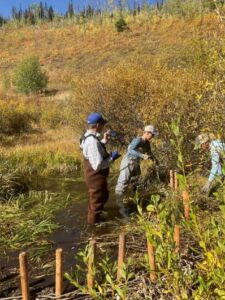Everyone knows that Washington is the smartest state in the country when it comes to beavers. Hardly a week goes by when I don’t see a headline boasting about all the wonderful things they do to help salmon and how they are going the extra mile just to keep them around. So when I saw this headline I was kind of means-spiritedly bemused. Like when the teachers pet in your fifth grade gets in trouble for smoking in the boys’ room.
How the world turns!
Big Lake residents fear another mudslide caused by beaver dam
With fears of another mudslide growing, many west Big Lake residents are tired of waiting for answers about what can done about a beaver dam uphill of the lake.
Memories of last fall’s mudslide, caused by a breach in a massive beaver pond uphill of homes, are fresh in the minds of residents, and their frustration about the lack of a fix came to the fore at a neighborhood meeting Monday.
Jim Beckett, who since last fall has bought the property on which the 17-acre pond sits, has no plans to do anything to fix the problem without a guarantee that he won’t be held responsible in the event of another mudslide.
 See last year was an actual flood that wiped out the road which was widely believed to cause by a beaver dam washout. Even though NOAA predicted that the river was going to crest that weekend because there was a load of rain.
See last year was an actual flood that wiped out the road which was widely believed to cause by a beaver dam washout. Even though NOAA predicted that the river was going to crest that weekend because there was a load of rain.
“On Friday, the National Weather Service put out a warning that the river was expected to crest in Mount Vernon late Friday night. According to NWS, the river reached 28.86 feet Friday which is considered minor flooding”
But still, why NOT blame a beaver dam if you get the chance? I mean making the county pay to kill some beavers is a helluva lot easier than reading a weather report and getting the neighbors together to lay sandbags or something.
County leadership has been aware of the threat the pond poses for years, but has failed to do anything, he said. Skagit County should be the one taking responsibility here, not a private landowner.
“The county, they dropped the ball,” he said. “I don’t want to get stuck with a bill.”
Neighbors have proposed pumping water out of the pond to reduce the immediate risk, then installing a pond leveling device to keep pressure from building behind the dam.
But little progress has been made to fix the problem since conversations started last spring.
Carolyn Bennett, one of the west Big Lake residents, said the neighbors have put forward a proposed solution, and she doesn’t understand why no one seems to be able to help.
So big Lake is a BIG LAKE with lots of streams feeding it. I can’t find a photo of a beaver pond but I assume there could be one. Not sure why beavers would live in one of those little streams when they have a big lake right near by. But okay, sure. Let’s say there’s a pond.
If mud and water again comes down the hill, “our houses will be in the lake,” she said Monday. Shelia Dodd said just pumping water out of the pond isn’t going far enough, and she’s tired of knowing that another mudslide could come at any moment.
She said she doesn’t want to hear about half-measures such as reducing the size of the pond, and feels the only way to solve this permanently is to remove the beavers and the dam entirely.
“If the beavers come back, take them out again,” she said. “It would make me sleep a lot better.”
Well she seems nice. Kill em all and if there are any survivors kill em again! The xena of beavers.
County Commissioner Peter Browning maintained that Beckett, as property owner, would be held legally liable, because flooding caused by the beaver dam is clearly a predictable problem.
“Once it’s predictable … you now own that liability,” he said.
At Monday’s meeting, Browning urged residents to put together a proposal for the commissioners, saying there may be some funding available to help pay for a fix.
But any plan hinges on permission from Beckett, which he says he will not give.
“I’m sure he will when he realizes he could potentially lose his property if there’s a lawsuit,” Browning said.
“That’s part of the neighbors’ job, to work with the landowner,” he said.
Alright Mr. Beckett, Let’s have a talk shall we? You are clearly a wise man who knows that beaver on the landscape make better wildlife and actually help slow down flooding. You installed a flow device to minimize the pressure on the dam and that was great. Your neighbors are still freaked out.
Maybe you are a hermit who would rather spend time with beavers than anyone in your neighborhood. I understand. Bit this is going to take beer. Lots of beer. You are going to have to have a lot of barbecues and talk about this over and over.














































